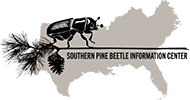Abstract
This laboratory study investigates the effects of constant temperature on reemergence of the southern pine beetle, Dendroctonus frontalis Zimmermann. Beetles reemerged at temperatures between 12.5 and 33.3°C, with the relationship of adult residence time and constant temperature forming a backwards “J” -shaped curve. Adult residence time was greatest at 12.5°C (46 days) and least at 27°C (12 days). The distributions of those limes changed with temperature. At 12.5 and 15°C, the distributions were near uniform, but as temperature increased to 30°C, the distributions became peaked and skewed right. Above 30°C, the distributions became less peaked. About 90% of the beetles reemerged at temperatures between 12.5 and 30°C, whereas above 30°C the percentage dropped precipitously. Males reemerged I or 2 days before females at temperatures below 30°C, but the reverse condition was found at 30°C or above. A two-component model is used to predict reemergence as a function of temperature. The first component describes reemergence rates as a function of temperature. The second component distributes the reemerging population over physiological time. When combined, these components distribute reemergence over calendar time, and are suitable for incorporation into a larger population model of D. frontalis.
